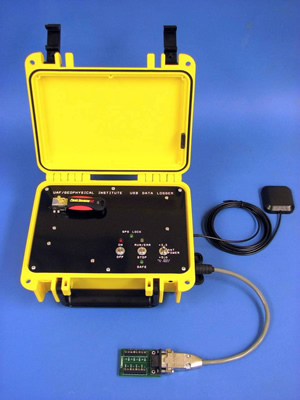New data logger offers functionality in small, inexpensive package
New data logger offers functionality in small, inexpensive package
Submitted by Amy Hartley
Phone: 907-474-5823
11/26/07

Download photo
Jeffrey Rothman and other staff at the Geophysical Institute’s electronics shop have developed a new, lightweight data logger that will allow all types of scientists to get their information from the field and to the office safely and quickly.
Enclosed in a rugged yellow case the size of a lunchbox, the data logger performs in one small package what scientists needed several instruments to do in the past. The data logger can take 10,000 samples per second, provide researchers with a precise GPS timestamp for every measurement taken and it records information directly to a USB jump drive. The device is affordable enough that if lava consumed it, a scientist’s entire project budget wouldn’t go with it.
Rothman believes the logger would be attractive to anyone recording data in a digital form--from seismologists recording earthquake signals to space physicists measuring photons in the upper atmosphere.
Rothman and staff members Rick Ruhkick, Jay Helmericks and Brian Fischer saw a need for the new device as they assisted Dave Sentman, a professor of physics at the Geophysical Institute, who needed a lightweight data logger to measure the electric field in the upper atmosphere. Sentman flew prototypes of the data logger several times at 70,000 feet on high-altitude balloons. When the data loggers worked reliably there, Rothman saw the feasibility of launching the new product.
Assistant research professor Chris Larsen, of the GI, has purchased five of the data loggers and will use them to gather seismic data on glaciers to see what sort of signals the glaciers make as they grind away bedrock. Larsen will also use one of the data loggers to gather wave-pressure information that will tell him how frequently icebergs calve from certain glaciers.
"They don’t use a lot of battery power, and they’ve got them set up where I can use a cheap memory stick (for recording data)," Larsen said. "And there’s so much memory, I can take measurements 100 times a second if I wanted."
The new data loggers are available for purchase through Chaparral Physics at the Geophysical Institute for $3,500.
NOTE TO EDITORS: Nov. 28, 2007, from 2 to 3 p.m., a demonstration of the data logger will take place in the Globe Room at the Geophysical Institute on the University of Alaska Fairbanks campus.
CONTACT: Jeffrey Rothman, electronics shop manager, at 907-474-7560. Chaparral Physics at 907-474-7107. Amy Hartley, information officer, at 907-474-5823.


